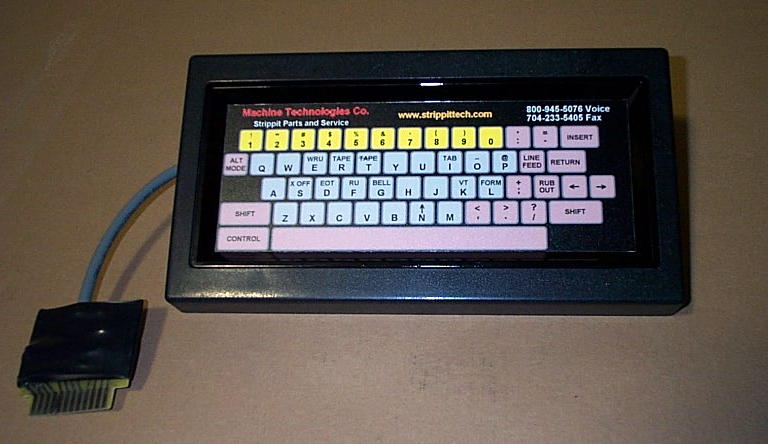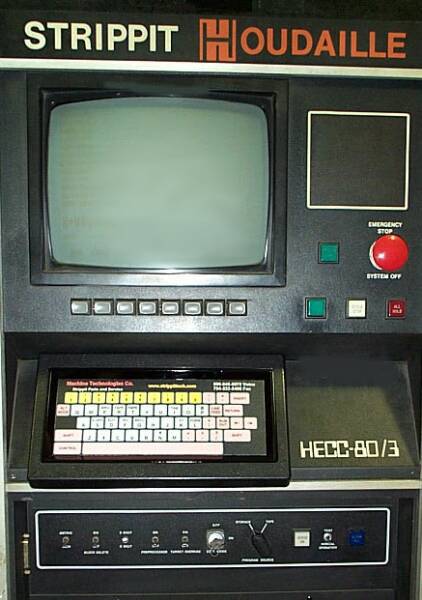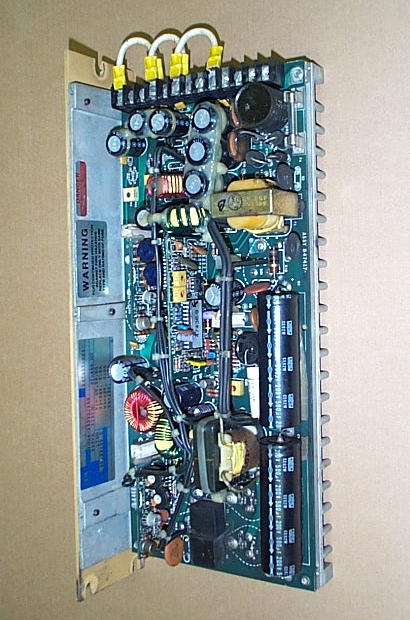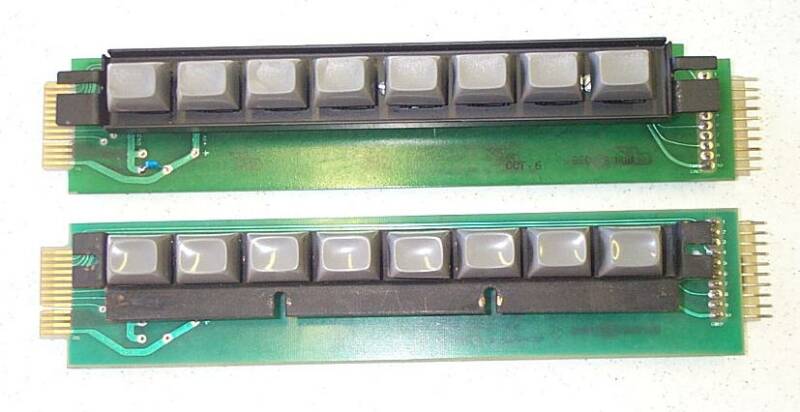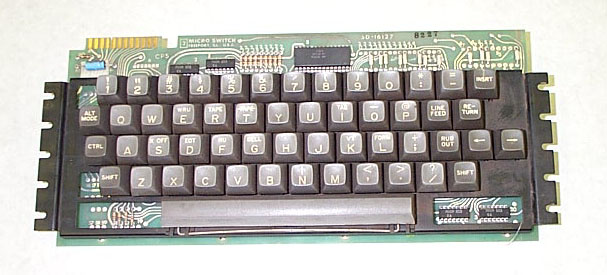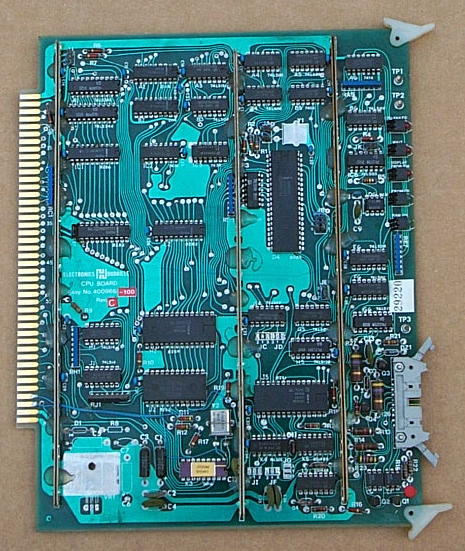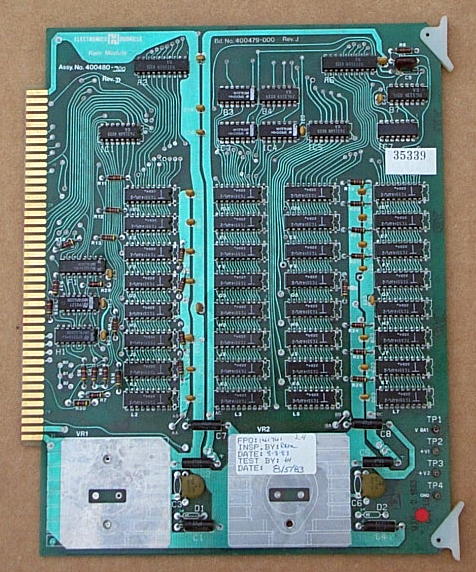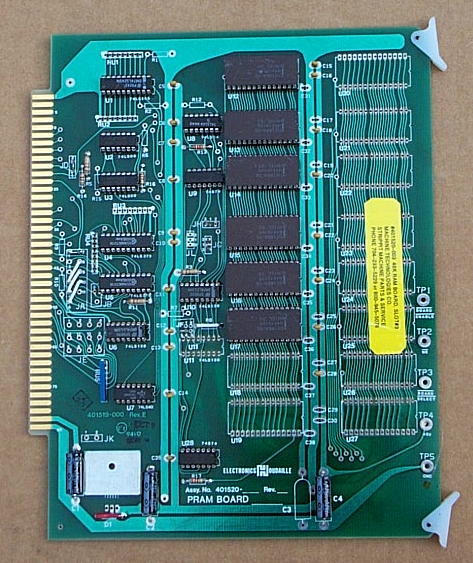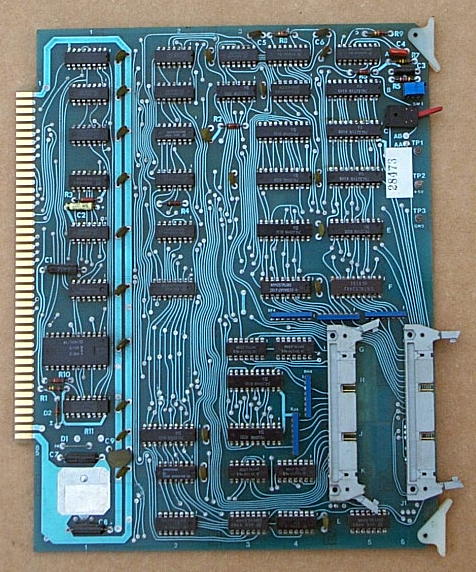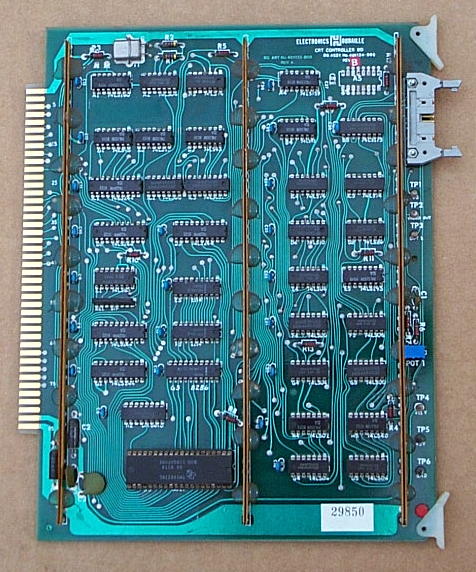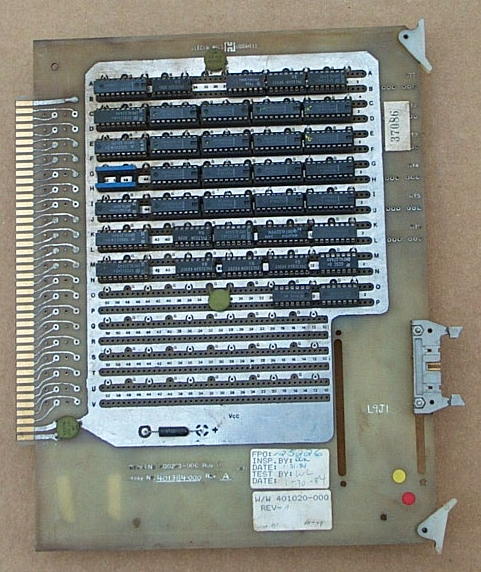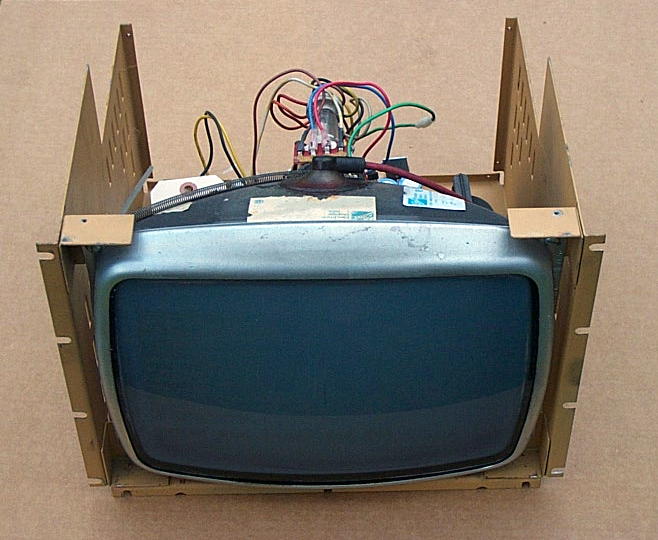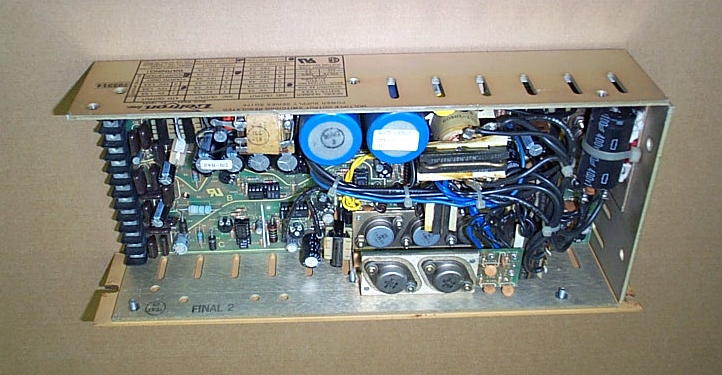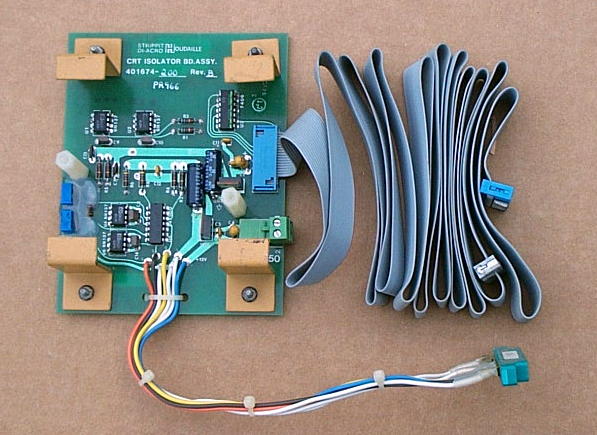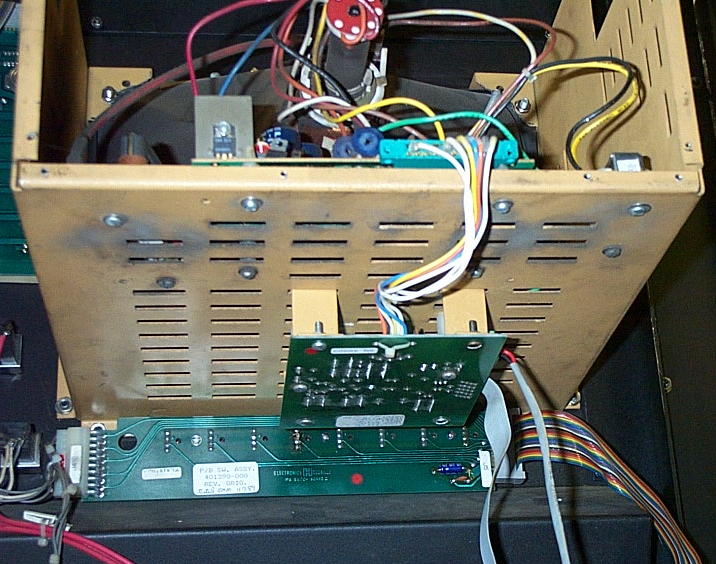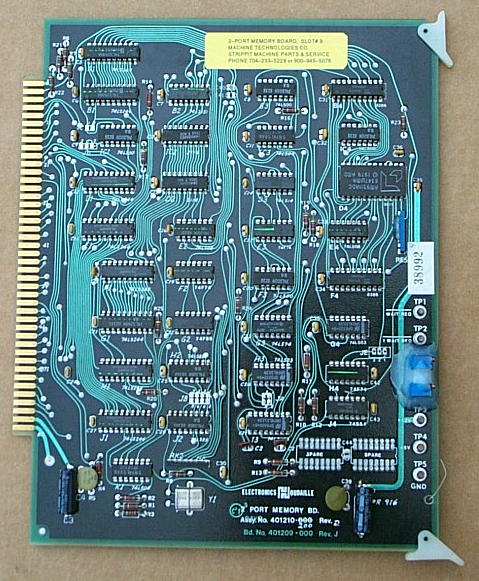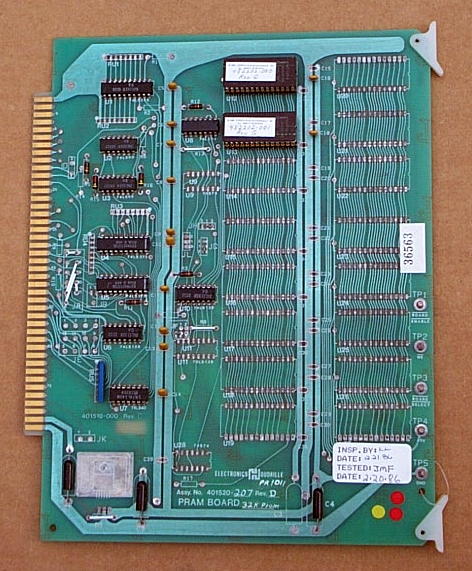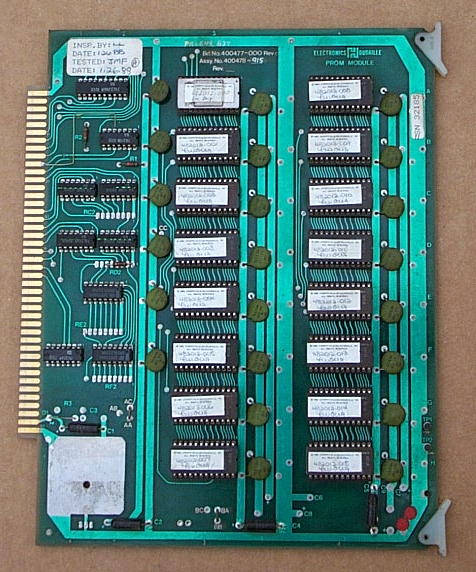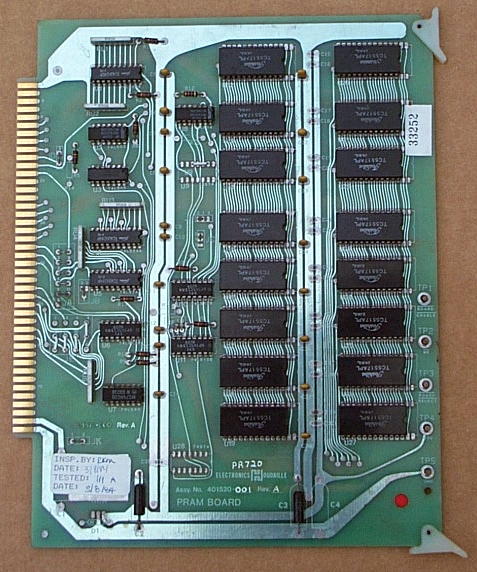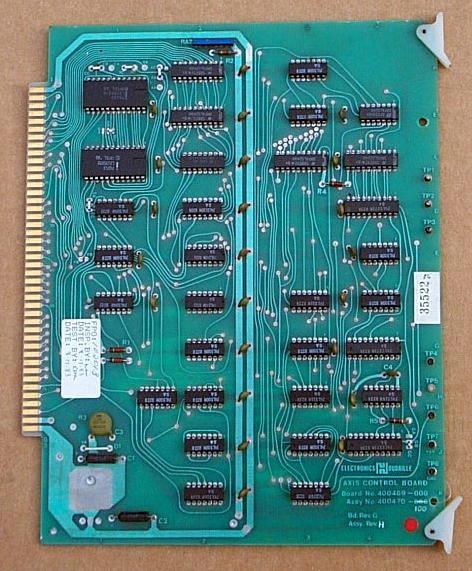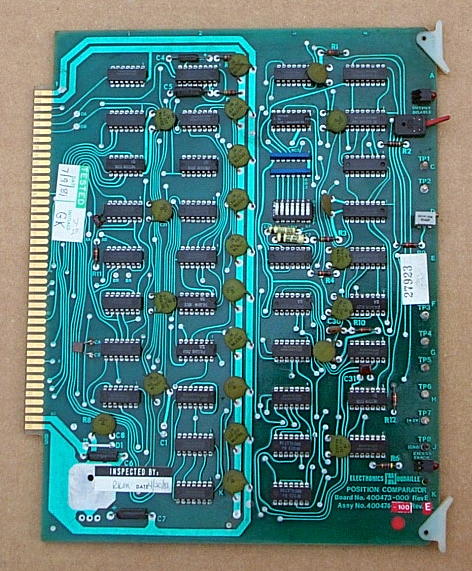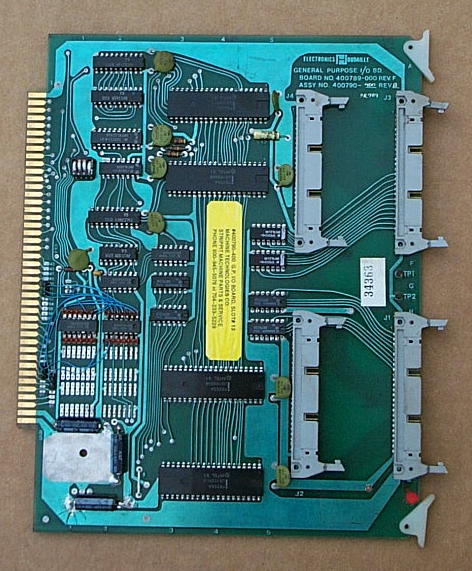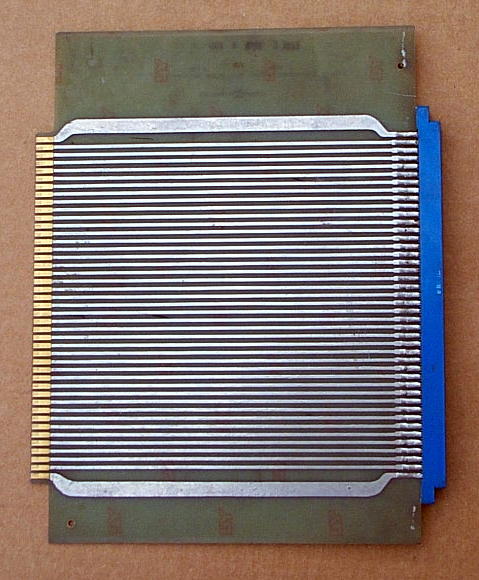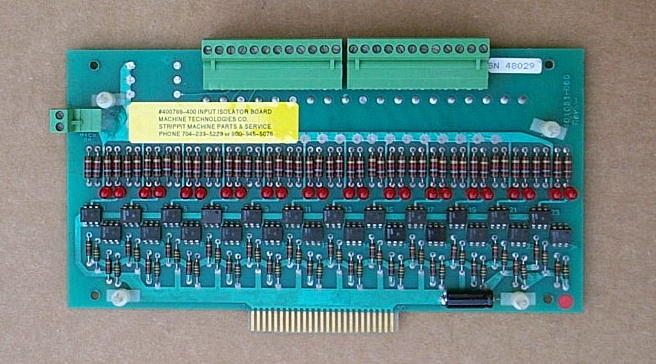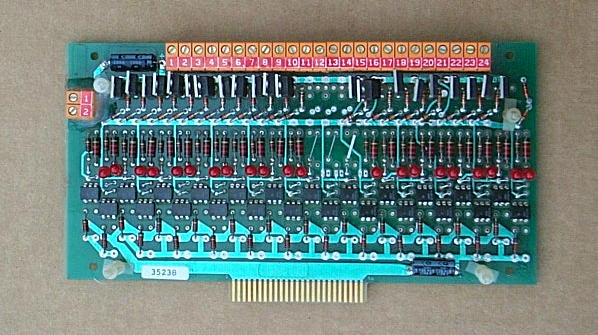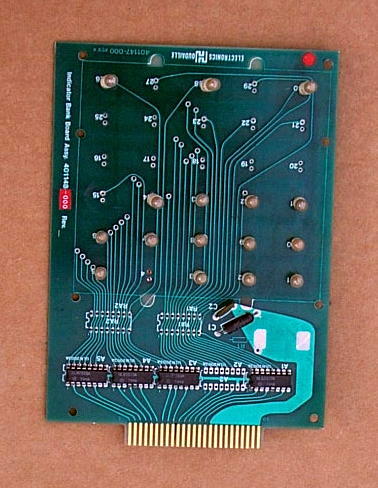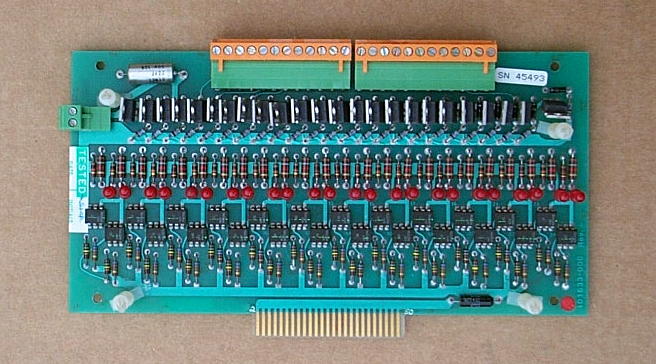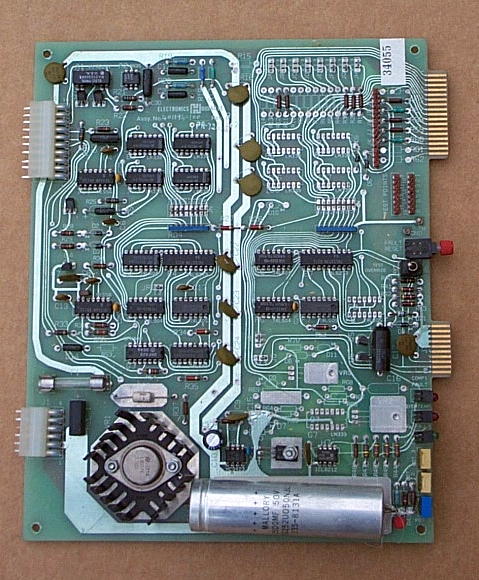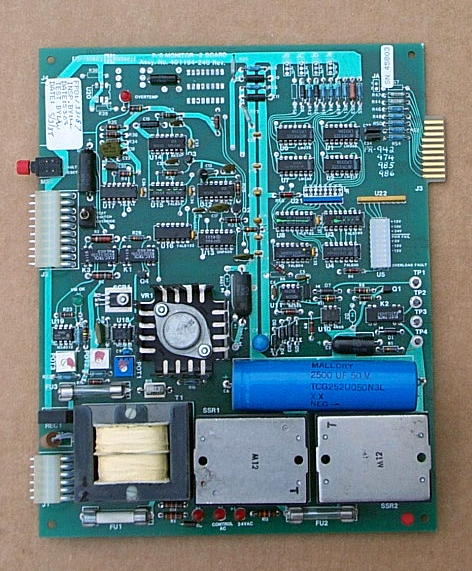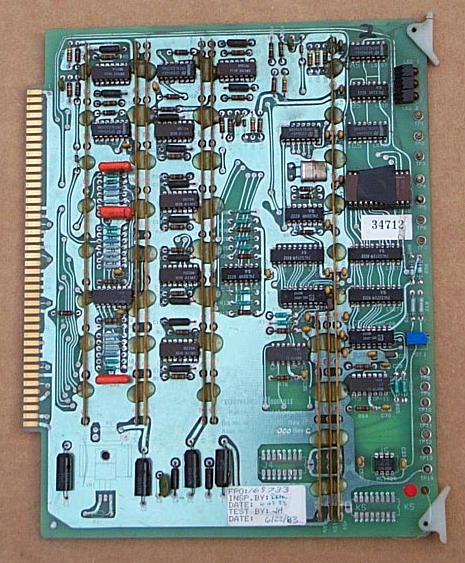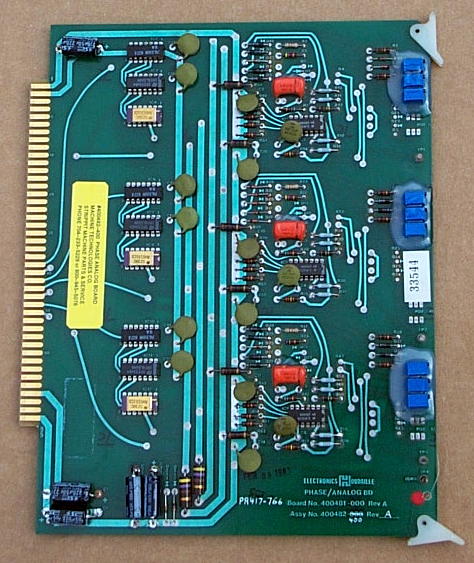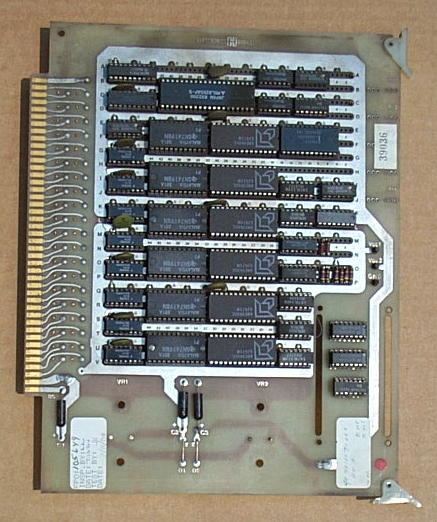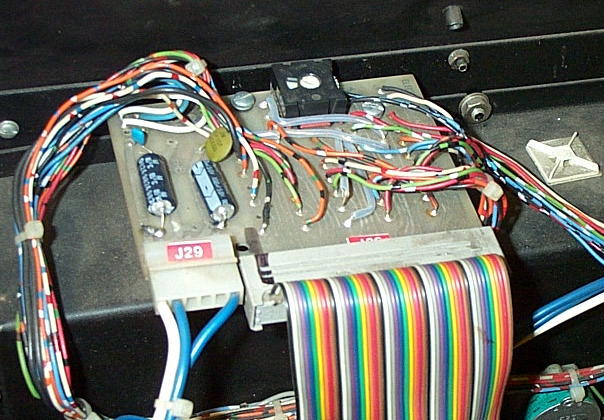Strippit Houdaille HECC80/3 Control
Circuit Board Types & Usage
This is a Listing of
Types & Usage
of the
Electronic Circuit Boards in
Strippit Houdaille HECC80/3
Type CNC Controls.
HECC80/3 CNC Controls
were Used on Strippit
Turret Punch Press
and
Laser Machines
Built in the 1981 to 1987 Period.
The HECC80/3 Type Controls
Look like the Picture to the Right.
If your Control Does Not look
like this Control, Go to Our
Web-Page to Properly Identify
Your CNC Control!
Note #1. Strippit Houdaille Circuit Boards have 2 Numbers on them.
The "Odd" Number is for a Raw-Blank Board with No Parts Installed on it,
and is of No Interest to You or Us.
The "Even" Number is for a Finished Assembly Circuit Board.
Example, the "Odd" Number #400965-xxx is for a Blank CPU Board. We are Only Interested in the "Even" #400966-xxx Finished Assembly Circuit Board Number!
Note #2. Strippit made Many Different Versions of some of these Boards that are Very Similar, But are Not the Same! Pay Close Attention to the Board (-xxx) Dash Numbers!
Note #3. Some HECC80/1 Boards and HECC80/3 Boards look Similar,
But are NOT Interchangeable! If you have more than 1 HECC80 Control Machine,
Make sure the Boards do Not Get Interchanged!
48K Ram Memory Board
#401520-003 48K Ram Memory Board
To Improve Reliability and Reduce Costs, 48K Ram Board was made to Replace 3 -- 16K Memory Boards previously used.
Boards were used on Later HECC80/30x Controls and were sometimes Retrofitted to Earlier Controls which Required some
Cardcage Rewiring.
1 Board was used in Control Slot #3.
Slots #4 and #4 were Now Left Empty.
Note, This is 1 of Pram Board Family.
Raw (No-Parts) #401520-xxx Pram
Boards were used to make a Whole Family of Prom & Ram Boards,
Hence the Name "Pram Board".
16 K Ram Memory Boards
#400480-600 16K Ram
#400480-700 16K Ram
#400480-701 16K Ram
#400480-702 16K Ram
Early Bubble-Memory Controls
(HECC80/302, 304, 306, & BC) used 3
16K Ram Memory Boards in Slots
#3, #4, and #5 to give a Total of
48K of Ram Memory for Temporary
Part Program Storage.
3 Boards were usually of 1 of 4 Types listed above, but some Controls have a
Mix of Various Types. Some Types were
"Improved" Versions for Increased Reliability, and some Types were Just Made to use-up old Stock Boards in Inventory. Its Best to Replace a Bad
Board with Same-Type.
CRT-Graphics Board
#401384-000 Graphics Board
This was a Hand-Made Wire-Wrapped Board
(Not a Conventional Eched-Copper PC Board)
because of the Low Production Volume,
that was Only Used in
HECC80/BC (Blanking Center) Controls
in Slot #9
that Worked in Conjunction with
CRT-Controller Board in Slot #8.
I think there is only 1 or 2 Blanking Centers Still Running in the World, so Information & Availability of this Board is Quite Limited.
Bubble Memory Board
#40135-000 Standard Bubble Memory Board.
Some Boards were Marked with other Dash (-xxx) Numbers representing Different Software Versions Loaded into them, but Old Dash-Number Type System is No Longer used on Bubble Boards. Use Standard Board & Load Proper Software for Your Machine.
HECC80/30x Controls actually Run under an Old Disk Operating System that Strippit Houdaille Licensed or Stole called CP/M. Strippit Houdaille Renamed CP/M "HOS"
for Houdaille Operating System. CP/M is comparable to old MS-DOS Disk Operating System. IBM almost went with CP/M instead of MS-DOS for their P.C. Computers back in 1980. Had they Done So, Bill Gates would be $150 Billion Poorer Today!
In HECC80/30x Control System, Bubble Board is used as a Solid State Disk Drive. Bubble Memory is Non-Volatile, Meaning once a Program is Stored on it,
it requires No Electric Power to Keep Programs Stored Indefinitely.
Board has 2 -- 128K Bubble Modules on it, 128K for Your Part Program Storage, and 128K for System Programs that Run Control & Machine. Board goes in Slot #6.
Boards are Quite Voltage Sensitive. Improper D.C. Voltages or Electrical Noise can cause Board to Dump it's Memory and Control will Start-Up with Various #DFxx Errors.
We can usually Repair these Boards, and Add Modifications to Improve Reliability.
There is More Bubble-Board Problem & Repair Information on Our
Web-Page "Bubble-Board Problems & Fixes".
Front Panel Controller
#400476-100 Front Panel Controller
Board, Slot #7
This is Board that "Talks" to All Control Panel Buttons & Switches, Keyboard & Soft-Key Keyboard, and Tapereader.
If You are using a M81 Post Punch Delay Programming Code, Control Looks at Switch Position on this Board to Determine if You want a 100 MSec. Delay (Switch Down) or a 250 MSec. Delay (Switch Up).
When Replacing Board, be Very Careful You Insert 2 Ribbon Cables in Correct Slot!
And Do Not Insert Cables Up-Side Down! On Multi-Color Ribbon Cables that were Usually Used, "Brown Wire"
Always Goes UP!
CRT Controller
#401124-000 CRT Controller Board,
Cardcage Slot #8
This is Board that Generates
TTL-Vidio Signals &
Supplies 12VDC Power
that goes through CRT-Cable
to CRT-Monitor Display
Mounted on CNC Control Door.
2-Port Memory
You have to Understand how HECC80/30x Controls Work. They all have
2 Computers Inside Splitting the Work.
L2 CPU Runs "Front-End" of Control, like Control Panel Switches, CRT, Keyboard,
Tapereader, Part-Program Storage, Etc.
L10 CPU Runs "Back-End"
for the 3-Axis Positioning Systems
and Machine Switches & Solenoids.
2-Port Memory Board is "Interface" Between these 2 Computers. Each CPU Board puts Data in this Board that it Wishes to Pass to Other CPU Board. Needless to say, a Intermittent Bad 2-Port Board can cause Limitless Odd Problems.
CRT Monitor Display
CRT Monitor Display that is Mounted on Control Door to Provide
"Man to Machine Interface". Displays Program-Data, Axis Positions, Error Messages, etc.
Strippit used Many Different
Part Numbers for these Monitor Assemblies over the Years.
And there were 2 Different Yellow
Metal Cases used, which,
Of-Course, are Incompatible.
CRT Isolator Boards
All CRT Monitors "Snap & Pop" as the Hi-Voltage (13,000 Volts!) Intermittently Arcs Inside Assembly.
It was thought that this Arcing was Back-Feeding through CRT-Cable to
Control Cardcage and Causing some Bubble Memory Board Failures.
Isolator Boards attempt to Isolate
CRT-Assembly from CNC Control to Stop "Sparks" from Disrupting Control.
CRT Isolator Boards were used on Late Model HECC80/30x Controls, and were sometimes added to Early Controls, in the Field, to try to Improve Reliability.
Board "Hangs" Underneath Yellow-Metal CRT-Assembly, and has a Ribbon Cable that goes to L8 CRT
Controller Board, a Signal Cable that Loops up to CRT-Assembly, and a 2 Wire Power Cable that goes Directly to 12VDC Supply & Ground.
There are at least 3 Types;
#401674-000 Original Type,
used Isolation Transformers.
#401674-200 2nd-Type, used Opto Isolators Chips for Better Performance.
#401674-100 2-Pot Design for use with
2-CRT Boards on HECC80/BC Control.
# 22069-000 CRT-Exchanged
#402844-000 CRT Assembly, Old-Style with "Smooth-Bezel that Sticks-Out"
#402844-000 CRT Assembly, New-Style with "Textured-Bezel that is Recessed"
#402848-000 CRT-1 Retrofit Kit, "Smooth-Bezel that Sticks-Out"
#402848-100 CRT-2 Retrofit Kit, "Textured-Bezel that is Recessed"
As Everyone Now Uses Color LCD Flat-Screen Monitors, these 12 Inch Monochrome TTL-Input Monitors are No longer in Production and there is No New Monitors.
They have a Fairly High Failure Rate from Cheap-Oriental Designs (several different Brands have been used) and Shock & Vibration from Control being Mounted on FC1000/3 Machines, So this can be a Problem.
However, We Can Often Repair or Replace a Bad CRT Monitor.
We Require that you Send-In All the Following Items, as it is a System.
1 -- CRT-Monitor Assembly
2 -- CRT-Cable
3 -- CRT-Controller Circuit Board, Slot #8
4 -- CRT-Isolator Board if 1 was used on your System, it Hangs-Below CRT-Cage.
We, and Strippit, have also made a Type of Replacement from Old P.C. Monitors.
These have A.C. Power Cord that Plugs-In to Power Strip or Wired-In to A.C. Power.
These Monitors do Not use CRT-Isolator Board, and do Not use 12 VDC Power.
In the Fine Strippit Tradition of Making Everything Overly Complicated,
There are 4 Types of 2-Ports Boards using 3 Part Numbers.
#401210-000 2-Port Memory Board, with No Math Chip, Made for HECC80/BC (Blanking Centers) which do Not use Math Chip. Board will work in other
HECC80/30x Controls if you do Not use the "Fab 5" Function.
#401210-100 2-Port Memory Board.
Early Board made Only for Special Caterpillar HECC80/2 Controls, which I think does
not Exist anymore. I don't Know what Differences are on this Board.
#401210-200 2-Port Memory Board. Standard Board for all HECC80/30x Controls.
Has Math Chip. Math Chip is Only used for running "Fab5" Function.
Late Versions of this Board were "Multi-Layer" (4-Layer) Type that appear Black.
Multi-Layer Boards were Built to try to Increase Control Reliability.
Note. The "Fab5" Function is a Carryover Programming Program from Olden Days Before Modern CAD/CAM Programs. It Allows a Small Information Macro Program such as a Grid-Program as small as 1 Line, to be "Fab5'ed". Fab5 will then Build a Expanded NC-Run Version from Macro-Information File in Control Memory that now has Hundreds or even Thousands of Lines of Code to Punch a Grid or a Big Perf Job.
Unfortunately, Fab5 Function is Not Supported by Any Aftermarket Programming Software as it is Not Needed anymore, and so is Very Rarely used today.
#400478-xxx Prom Board
Everyone Calls them Prom Boards, But are Really Eprom Boards, as Strippit used only Eproms Chips which are
Erasable Programmable Read Only Memory.
Proms & Eproms are Memory I.C. Chips where you can Program-In & Store your Data, and it stays in Chips More or Less Permanently,
even when Power to Board is Turned Off.
Typically, Prom Boards Store Executive-Run Programs that Run Control & Machine.
HECC80/3 Non-Bubble Board Controls on Early FC1000/3 Machines had a #400478-900 Control Prom Board in Slot #3 for L3 "Front-End" CPU.
L10 "Back-End" CPU used #400478-901 Machine Prom Board in Slot #11.
Later HECC80/302, /304, /306, and /BC
Controls all get their "Front-End" Instructions from Programs Stored in L6 Bubble Board.
"Back-End" L10 CPU used Data from
#400478-905 Machine Prom Board in Slot #11.
Some Early HECC80/302A Controls used a
#400478-915 Prom Board using 16 Eproms.
#400478-xxx Boards in HECC80/30x Controls
used 2716 Type Eproms. There are Many
Different Machine & Control Software Versions Stored in these Boards,
and Replacing a Bad Board can be Tricky!
#400520-xxx Prom Boards
Later HECC80/30x Controls used another Version of the "Pram" Board Family.
These Eprom Boards used only 2 -- 27128 Type Eprom Chips in Slot #11 for
"Back-End" L10 CPU.
#401520-007 HECC80/304 for FC1500/45
#401520-017 HECC80/304 for FC1500/45 3-chip
#401520-107 HECC80/302 for FC1000/3
#401520-117 Some HECC80/302A on FC1000/3
#401520-207 HECC80/BC for Blanking Center
#401520-307 HECC80/306 for FC1250/30/1500
#401520-317 HECC80/306 for FC1250/30/1500,
3-Eprom Chip for Level 2
Software & -100 Bubble Res-Prom
Note, There is a Cornucopia of Different Eproms for these Boards depending on Options -- Loader & Unloader, Plasma, Laser & Type of Laser Used, Etc. It can be Difficult to Replace Boards because of Many Different Software Revisions & Option Types.
32K Ram Memory Board
#401520-001 32K Ram Memory Board
was First Board of the Family of
"Pram" (Prom and Ram) Boards.
This was a 32K Memory Board that was Only Used in Original HECC80/3
(No Bubble Memory) Controls on
First 30 or so FC1000/3 Punch Machines.
2 Boards were used, in Slots #4 & #5.
Memory Boards were Power Backed-Up with a Ni-Cad Battery Pack so that they would Retain your NC Part Programs that had been Loaded into this Memory even when Control was Turned-Off.
Most of these early FC1000/3 HECC80/3 Controls were Retrofitted in the Field to HECC80/302 Bubble Board Status.
Cardcage was Rewired, Memory was Replaced with 3 - 16K or 1 - 48K Memory
Boards and a Bubble Board was Added.
CPU Board
#400966-100 CPU Computer Board.
2 of these CPU Boards were used in All
of the HECC80/30x Controls,
1 in Slot #2, and 1 in Slot #10.
All Boards were Set-Up for RS-232 Input.
Most CPU Boards were the Standard
2-Layer Type, But some Later Boards were the 4-Layer Type (2 Signal Planes, a Power-Plane, and a Ground-Plane) and Boards appeared Black, because Light would Not go through these Boards. 4-Layer Boards are Considered More Reliable than 2 Layer Type.
CPU's are the
"Computer Brain" of CNC Control,
if they are Not Working, Nothing will Work!
In Normal Operation, there will be
2 Green-LED Lights "On", and the
3 Red-LED Lights will be Very-Dim or "Off".
This page was last updated: June 2, 2025
General Propose I/O Boards
G.P. I/O (Input/Output) Boards are how L10 CPU Machine Computer Receives Signals from Machine Switches and Issues Commands Out to Solenoid-Drivers to Machine.
#400790-200 Slot #12 in HECC80/302 & 306
Slot #14 in HECC/BC Controls
#400790-201 Slot #13 in HECC80/302 & 306
Slot #15 in HECC80/BC Controls
#400790-204 Slot #12 in HECC80/304
#400790-400 Slot #13 in HECC80/304 for
Thermal Dynamics Plasma?
#400790-500 Slot #13 in HECC80/304 for
Hypertherm Plasma?
I/O Isolator Boards
These Boards Provide Opto-Isolator
I.C. Chip Isolation between Control & Machine to Help Prevent Problems like Electrical Noise and Ground-Loops.
There are 2 Main Types;
Input Isolators which Connect to Machines Switches & Sensors.
Output Isolators which Drive
Machine Solenoid Valves.
#400788-300 24-Output Isolator Board with 21 Transistor Solenoid Drivers
and 3 Opto-Isolator Outputs Used to Remove 3 Servo Drive Inhibits.
#400788-400 24-Input Isolator Board.
#400788-500 ???
#400788-600 24-Output Isolator Board with 24 Transistor Solenoid Drivers and has 2 Diode Back-EMF Suppressor Diodes on Each Driver Output.
Used on "Cell-Systems" ???
Note,
Different Types of Boards had Different Numbers of Eproms.
L11 Machine Prom Boards Usually had 11 or 12 Eprom Chips.
Board Pictured Above is 1 Example of this Type of Eprom Board.
Note #1, Early Boards were Very Sensitive to Humidity, Inputs & Output could be "Fired" by Even Breathing on them! Later Boards had Extra Resistors Added to
Opto Chips to Decrease this Sensitivity. Often is Best to Replace Early Boards!
Note #2, Early Boards had Screw-Terminal Strips on Board's Wire Inputs.
So it was a Pain In The Ass to Swap Boards for Quick-Testing as Each Wire had to be Individually Removed & Reinstalled on New Board. Later Boards had
Quick-Disconnect Wire-Connectors so Board could be Simply Unplugged.
Be Aware of this when Ordering a Replacement Board, Later Boards are Best!
Position Comparator Board
Board Compares Control's
Axis Position-Command and
Actual Axis-Position,
to Generates a Error-Signal for
Phase Analog Board & Servo Drives to
Use to Move to Commanded Position.
#400474-100 Axis Control Board,
this 1 Type was used in
All HECC80/30x Controls.
Used in Following Cardcage Slots;
X -- Axis Board in Slot # 19
Y -- Axis Board in Slot # 20
T -- Axis Board in Slot # 21
Note! Switch is Only used in a Certain
Test Procedure that You will Never Use.
In Normal Operation,
It Does Not Matter if Switch is Up or Down,
But I Normally have All 3 "Down".
Axis Control Board
#400470-100 Axis Control Board
Only this 1 Type was used in All
the HECC90/30x Controls.
Used in Following Cardcage Slots;
X -- Axis Board in Slot # 16
Y -- Axis Board in Slot # 17
T -- Axis Board in Slot # 18
Axis Control Boards
contain the Logic that Initiate and Control Axis Moves.
Phase Analog Board
Phase Analog Board Converts
Position Comparator Board's
Error-Pulses into a
D.C. Analog Voltage for
Axis Servo-Motor Drives to use.
As there are Many
Differences & Variations in Components & Machine Axis,
there are 3 Pots (Potentiometers)
to Adjust & "Tune"
each Axis for Proper
Positioning Characteristics.
#400482-400 Phase Analog Board
is used in all HECC80/30x Controls
in Slot #22
Resolver Excitation Board
Resolver Excitation Board
Generates Sine & Cosine Signals
that are used
to Excite the Resolvers in
Position Feedback Packages
on End of Each
(X, Y, T) Axis Servo Motor.
#401272-000 Resolver Excitation Board, 3MHZ Sine-Wave Type.
This Board was used on all
HECC80/30x Controls in Slot # 23.
Monitor Boards
There were 3 Different Type of Monitor Boards used in the HECC80/30x Controls.
#401194-000 Used Only on Early FC1000/3 Machine's HECC80/3 (Non-Bubble) Controls.
#401194-100 Used on All Early HECC80/30x Bubble-Memory Type Controls.
#401194-240 Used on Late HECC80/30x Bubble-Memory Type Controls.
The 3 Board Type are Not Interchangeable.
Board was Mounted on Power Panel on Side or Back of Control Cabinet.
Monitor Board has 2 Main Functions;
1 -- If 3-Phase A.C. Power to Machine is On,
then this Board is Powered-Up with it's Green LED Light ON, and is Ready to
Turn-On Control when you
Push System-On Button.
2 -- When Controls is Turned-On,
Monitor Board "Monitors"
Control's D.C. Voltages.
If any are Too High or Too Low,
Board will Turn-Off Control to Protect itself.
Softkey Keyboard
#401390-000 Softkey Keyboard
8-Key Keyboard Mounted
Directly Below CRT Monitor.
Each Key is "Labeled" on CRT Display above, and Key's Name & Function Changes depending on Control Mode at that Time.
Indicator Bank Board
#401620-000 Indicator Bank Board
is a Group of "Idiot Lights"
that the Control,
through G.P. I/O Boards,
Tries to Tell you Something like "Load Position", "Axis Limit",
"Servo Overtemp", Etc.
Board is Mounted on Back of Control Door, and Shines through
Control Front Template.
Board uses Soldered-In #CM7362
5 Volt D.C. Light-Bulbs,
that are Usually Burned-Out,
and are a Pain to Replace.
Continuous Contour Board
#400888-100 Continuous Contour Board
Is a Dedicated Computer that Calculates Small X & Y Moves Continuously to
Allow Laser and Plasma Machines
to Make Smooth X & Y Axis Movement
for Cutting Purposes.
Board is Used in Slot # 14.
Keyboards
At Left is Original #22359-000
Microswitch Keyboard that was Custom-Made for Strippit Houdaille HECC80/30x Controls.
Keyboards are Not Usually Repairable, and are No Longer Manufactured. As Controls are Unusable without a Good Keyboad,
this is a Problem.
Power Supply
Below is Deltron Power Supply that was used on Early HECC80/30x Controls. They had some Reliability Problems as they were often
Shook-Apart by FC1000/3 Vibration.
They were Replaced with More Rugged L.H. Type Power Supply show at Left. These Power Supplies were Further Ruggedized by Strippit by Adding
Wire-Ties & RTV-Silicon to Components that could Move & Break.
We Stock these #401491-000 Power Supplies.
More Information on Power Supplies and their Voltages Settings, go to Our Web-Page
Extender Board
#400322-000 Extender Board
Used by Service Technicians to Extent-Out of the Cardcage
a Circuit Board so that it can be Probed & Tested
with Volt Meters & Oscilloscopes.
Every HECC80 Control Build
Shipped from the Strippit Factory
with 1 of these Extender Boards
in it's Cardcage.
Transition Boards
#400880-xxx Transition Boards were made in Many Different Versions for the Various
HECC80 Control Versions.
Boards were used to "Transition" between
Hard-Wiring From Panel Switches, Tapereaders, Etc. to Ribbon Cables to take Signals
to Control Boards.
At Back of this Board is Black
"Thumb-Wheel" Rotary Switch that is Used to Set RS-232 Baud Rates, That Many Customers Can't Seem to Find.
Every HECC80 Control has One. We Set Thumb-Wheel to "A"
for 2400 Baud which Works Well on HECC80/30x Controls.
Top Softkey Keyboard is Later "B" Type. Lower Keyboard is Earlier "A" Type.
Difference is Slight Difference in Mounting to the Control Door,
But are pretty much Interchangeable.
More Information is on my "Special HECC80 Parts" Web-Page, Look there!
New Softkey Keyboards are Available or We Can Repair Yours in Only 1 to 2 Days.
To Fix this Keyboard Problem,
We have Engineered a New Replacement Keyboard.
New Machine Technologies Keyboard Covers the Old Keyboard Panel Hole, Plugs Right into Cable, and can be Installed in Minutes.
More Information is on our
"Special HECC80 Parts" Web-Page.
We have some CRT Monitor Displays and LCD-Flat Screen Displays
In-Stock! Call if you need a New Display for your Control!
